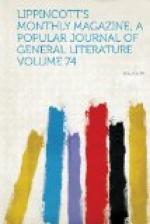The rifle is, in its simplest form, a more complex instrument than the smooth-bored piece, and will always require superior intelligence to manage it. The army which naturally possesses this requisite in the highest degree will best handle this decisive weapon, and be, other things equal, the strongest army. This consideration operates in favor of our people, among whom the rifle has always been in so much more constant and familiar use than with those of other countries. Our broad forests will have to be cleared and our mountain-chains, east and west, more densely settled than Switzerland, before the distinction of a nation of marksmen can be lost to us. So far, there is little evidence of this change. The deer and the wild-turkey are nearly as abundant on the Atlantic slope of the Alleghanies as they ever were. Probably there are more of both in Virginia than at the time of the settlement of Jamestown. Like the quail and the bee, they are favored by a certain advance of population and cultivation.
Another species of aborigine does not similarly thrive in the path of the rifle. The Indian of the Plains is still troublesome occasionally, but far less so than when blue-coats and blunderbusses joined forces against him. The odds then were often on his side, for many of the red men were armed with the rifle, while the troops had but the musket and carbine. The appearance of the breech-loading rifle in the hands of the United States dragoons on the frontier just fifteen years ago let in new light upon the Camanche and Apache mind. Up to that period the badgering of a detachment of “heavies” was a favorite pastime with these gentry. They got up their “spring fights” with as much coolness and regularity as the early patriarchs of Texas are related to have done, and not merely, as in the case of the latter, in utter contempt, but directly at the expense, of the constituted authorities. Tying a bag of dried mule-meat and pounded corn to the peak of his saddle, fashioning a small supply of arrows, or balls if he boasted the spectre of a gun, coloring the inferior half of his frontispiece a rich vermilion and the upper a delicate green, with ramifications of lampblack coursing tastefully along the cheek-bones and the bridge of the nose, twisting a crane’s feather into the tail of his horse, and giving his affectionate squaw a farewell kick, the cavalier of the prairie was ready for a raid on the Long-knives. Making a rapid night-march or two, he would carry the “latest intelligence from the Indian country” to the border ranches of Texas or New Mexico. Stampeding all the horses and mules that stood or ranged convenient, and under favorable circumstances some cattle and sheep, and “gobbling” on occasion some incautious Cyrion or Phyllis of the Western Arcadia, the marauder made for the mountains. By the time he had well passed the last outpost the hue-and-cry was at his heels, followed, after an easy-going delay, by the lumbering dragoon. The soldier, armed




